Economics
Altcoin Investing for Beginners
Table of Contents
What Is a Blockchain?
The Power of Digitized Assets
How to Buy/Sell Cryptocurrencies
What is a Cryptocurrency Exchange?
How to Set Up…
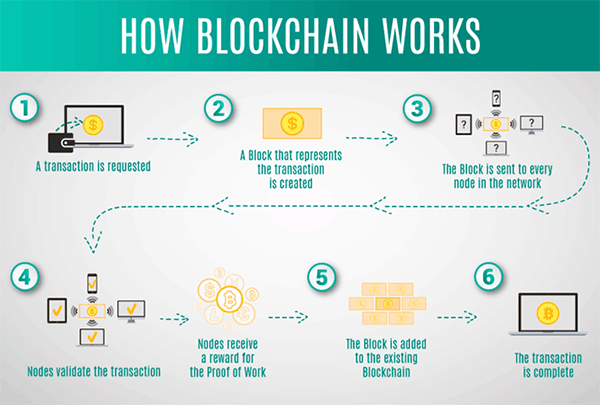
Table of Contents
- What Is a Blockchain?
- The Power of Digitized Assets
- How to Buy/Sell Cryptocurrencies
- What is a Cryptocurrency Exchange?
- How to Set Up a Coinbase Account
- Buying/Selling Your Remaining Altcoins on Binance and Other Exchanges
- How to Store Your Cryptocurrency Safely
- Summing Up
The advent of the internet has transformed the way we conduct commerce around the world.
Today, 57% of the global population uses the internet every day. In 2018, e-commerce tallied more than $2.8 trillion, a roughly 14% rise from the year prior.
Thanks to the internet and the technologies that have been built on top of its foundational rails, we can read and learn as much as we like about any topic on the planet at any time.
We can communicate with people who live just about anywhere, or send our family and friends photos and video clips. We can determine our precise location on the Earth and navigate where we’re headed, and we can buy or sell just about any good or service imaginable – all in real time.
If we choose, we don’t have to leave the comfort of our homes to do any of these things – it all can be brought right to our fingertips wherever we have a signal.
In other words, by moving us from the analog world into the digital one, the internet has exponentially expanded the convenience, efficiency, and speed with which we are able to conduct our affairs.
But we’re not even close to maxing out its potential.
We believe the giant leap into the digital frontier is really an ever-evolving process that’s just getting started. And the next step we’ve spotted on the horizon is going to make those who saw it coming – and knew how to respond – filthy rich.
We’re talking about money. Digital money in this case. And we don’t mean simply digitizing the massive money supply that already exists and then relying on the same intermediaries – the banks and money-changing services – that take their cut along the way. The crash of 2008 proved to the world the unreliability of our very centralized banking system… and its potential to crater our savings.
2008 was also the year when bitcoin came on the scene with a revolutionary new approach to money that doesn’t rely on a small group of bankers huddled in financial centers around the world making sometimes sensible, sometimes awful decisions about our money supply. Instead, bitcoin’s decentralized community of users – all of us – control this new world.
Bitcoin and other cryptocurrencies have developed into a whole new asset class that can serve as a store of value – like gold – and as a go-to means of value exchange – like the U.S. dollar.
These assets, which were designed and built for the internet age, can be traded on a peer-to-peer basis (directly with somebody else) or through online exchanges. Crucially, thanks to blockchain technology, this can all be done without fear that the digital transactions will be falsified by our peers. In other words, it can be done in a highly secure and “trusted” way. That’s the real breakthrough of blockchain technology. We can trust that our digital cash is legitimate, without needing a bank CEO’s confirmation in any way.
In this report, we’ll explain to you what the technology behind bitcoin and countless other cryptocurrencies is. And we’ll show you how and where you can buy and sell your crypto – the latter can change, depending on the coin – while keeping your money safe and sound.
So let’s get started.
What Is a Blockchain?
Many people describe “the blockchain” as a decentralized ledger of transactions. A fancy sort of Excel document, for instance, that everyone can read at the same time but whose past contents no one can erase, alter, or manipulate.
That’s accurate… but not quite complete.
Blockchain is indeed a decentralized, public ledger. (There are also private or enterprise blockchains that have a limited number of private members, but we’re not focusing on them here). It is maintained through an open-source software protocol, meaning anyone can read and review this software, and anyone can run the code that defines the rules and parameters of its network and operation on their own computer, also known as a node. Because no single person runs this thing, there is no single point of failure.
So blockchain gives users a way to reach an agreement about a common digital history without having to trust a middleman to step in. This is a very important problem that the technology has solved.
It means digital transactions can’t be faked. We can now use the blockchain to create new forms of money that incorporate all the convenience of the internet, opening up a whole new world of digital value.
The blockchain also combines two other technologies that make it unique and important.
Those technologies are private key cryptography, which helps prove users are who they say they are, and a protocol that incentivizes participants to do the “housework” that’s needed to keep the whole thing running smoothly. Namely, the protocol’s security and record-keeping.

Private keys are essentially your personal keys to your own crypto vault. They also allow users to release the smallest amount of personal information that are needed for an exchange, which helps reduce exposure to hacks.
The blockchain protocol includes the rules of the road that everyone participating must follow, so they do needed things like broadcast the correct transaction type. It also lists the rewards for doing so.
The bottom line is that bitcoin uses a blockchain to decentralize payments.
There are many other applications for a blockchain. Just about any service where a middleman exerts undue influence could potentially be helped along by introducing a blockchain – business payments, real estate transactions, personal medical information, and so much more.
But one area we’ve got our eyes on that could hold the most potential is the world of digitized assets.
The Power of Digitized Assets
Think about it. If you want to buy a house, a choice piece of real estate, stocks and bonds, a work of fine art, or even a slice of the next blockbuster Hollywood movie, it’s going to cost you in terms of costs, fees, and more time – thanks to the ever-present middleman.
These costs vary by degree, but they all add friction and frustration to the benefits that more open markets can provide.
Take real estate, which IBM says is worth roughly $217 trillion on a global scale.
As anyone who’s ever been involved with a real estate transaction is painfully aware, the process of buying or selling is long, drawn out, and requires filling out a virtually endless supply of mind-numbing paperwork.
But there’s a better way – using blockchain technology.
See, the blockchain allows us to digitize real-world assets like real estate and move them onto a secure blockchain, where they can be bought or sold in real-time.
Wall Street has been packaging various mortgages, car loans, and personal debt, for example, since the 1970s and selling these “securitized” instruments to investors. Tokenization brings this process to the next level.
Basically, the rights to an asset are digitized onto a “token,” which can be traded on a blockchain.
Doing so immediately opens up what was a mostly closed-off transaction into an instantly more liquid and tradeable one.
Having a digital token also allows units of ownership to be divided into smaller, more affordable fractions. These digital tokens can then be bought and sold across digital networks and international borders in the blink of an eye.
Want to be like one of those famous, globe-trotting real estate developers and grab a piece of income from that gleaming office tower on Fifth Avenue in Manhattan? In today’s world, you’d likely have to shell out millions or even billions of dollars to get in. With tokens, you could potentially shell out mere thousands to obtain your share of the building.
There are already more than a dozen companies using blockchain technology to decentralize the real estate sector and make digital transactions like these a reality.
The idea is to use the blockchain to unlock massive amounts of previously unattainable value.
The $1.9 trillion global payments market is another example of a sector that’s ripe for disruption by a good blockchain tokenization solution. HSBC made moves to use a blockchain to support the financing of soybeans in 2018, while Commerzbank in Germany also launched a pilot project to test the technology.
Investors will even be able to stake their claim in the latest potential Hollywood blockbuster as blockchain entrepreneurs set up projects offering fractional ownership of film, TV, music, and other intellectual property-driven content. One such project will allow owners of Proxicoin, a digital token, to invest in hundreds of major films and TV shows.
The possibilities are tantalizing, which is why we find this area so exciting and one to keep an eye on going forward.
While we watch this sector closely, there’s one blockchain application that’s already arrived – cryptocurrencies.
Now that we’ve explained a bit about the potential lining up behind the best crypto projects, let’s delve into the details of how to go about buying and selling them.
How to Buy/Sell Cryptocurrencies
This is the number one question we receive from people interested in cryptocurrencies. Unfortunately, you cannot log into your online brokerage account and place a buy order for bitcoin at the current price. One day soon that likely will be an option, but for now it is a little more tedious.
The rules surrounding cryptocurrency transactions vary by country. If you’re living outside the United States, you’ll have different rules, so it’s important to look up your country’s laws before you get started if you’re not living in America. This guide is for those who live within the United States.
First, a few definitions that will help you get a basic understanding of the terms and concepts you’re likely to run into and should know while you’re investing in cryptocurrencies.
What is a Cryptocurrency Exchange?
A cryptocurrency exchange is a platform that allows an investor to buy and sell cryptocurrencies. Depending on the platform, it may be possible to exchange cryptocurrency for cryptocurrency or fiat currency for cryptocurrency. Examples of fiat currency are the U.S. dollar, the euro, etc.
The larger coins such as bitcoin, Ethereum, and Bitcoin Cash can be purchased with fiat currencies easily. Smaller coins, often referred to as altcoins, are not as liquid and must often be purchased with bitcoin or Ethereum.
For example, on Coinbase, as of mid-September, you are able to buy 30 different cryptos that include bitcoin, Bitcoin Cash, Dai, Ethereum, Ethereum Classic, LINK, Litecoin, XLM, XRP, and more with U.S. dollars. On the Gemini crypto exchange, you can now buy 12 cryptos with U.S. dollars.
Make sure to stay up to date on these offerings, as the two crypto exchanges are continuously adding new coin that are available to be bought in U.S. dollars.
There are a handful of other exchanges that allow purchase of a few coins with U.S. dollars. However, when you start to look at buying coins not in the top 10 based on market cap, it gets a little more difficult to trade.
There are a variety of cryptocurrency exchanges on the market, but the place to start is with one of the most widely available (in the U.S.) and easy-to-use exchanges: Coinbase. Coinbase allows you to purchase crypto with a credit or debit card or through a wire transfer, and it stores the crypto for you.
How to Set Up a Coinbase Account
The first thing you need to do to set up an account is access the website. You can also download the free app if you prefer to trade from a mobile device, but for demonstration purposes we’re going to use the actual website.
On the home page you’ll see a place to sign up.
Enter your email address in the box provided and click “Get Started.”
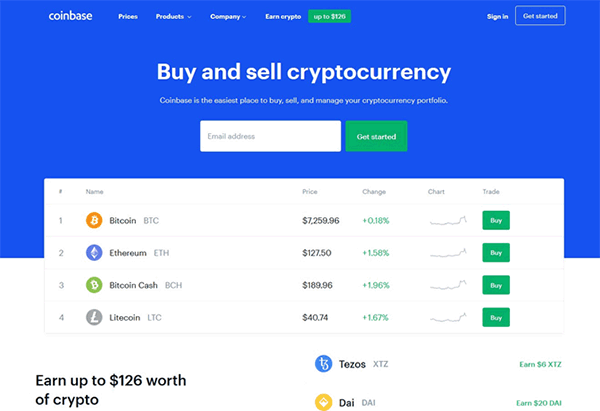
Enter your personal information. Be sure to check the “I’m not a robot” box as well as the one that certifies you are over the age of 18.
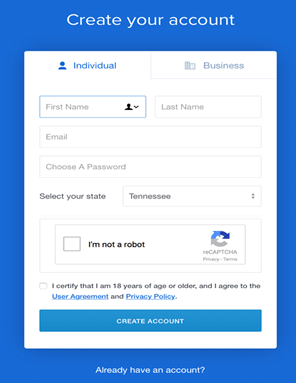
Once you’ve done that, you’ll receive an email from Coinbase. Open the email and click the link to verify the address you provided. Check your junk folder if you don’t see an email in your inbox. If it never comes, try starting over and making sure that you type in the correct email address.
After you’ve clicked the link, you’ll be taken back to the Coinbase website.
There you’ll need to enter a mobile phone number and then type in the seven-digit code that you receive via text message.
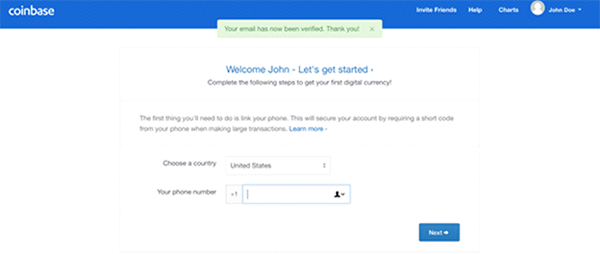
Congratulations! Your Coinbase account is active and ready for use. But before you can do any trading, you’ll need to add your funds. There are several ways you can do this, such as connecting to a bank account, providing credit or debit card information, or utilizing a wire transfer.
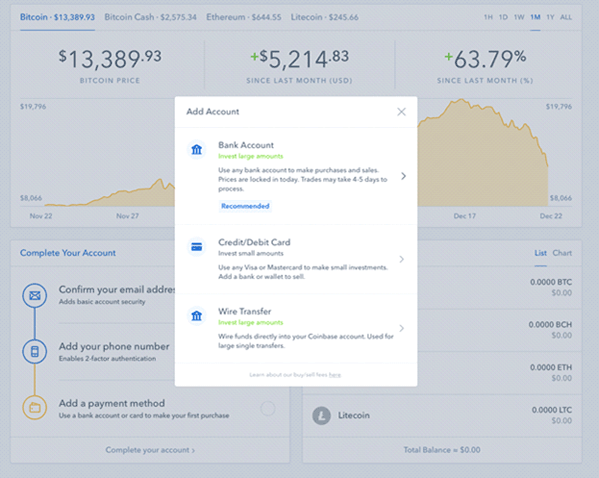
Funding your account is as simple as following the website’s prompts. You can start with just $25 if you want. Once your money is where it needs to be, you can begin buying and selling coins!
To buy or sell bitcoin or our recommended altcoins, follow these simple steps:
First, sign into your account using the two-step method, and then click on “Trade.”
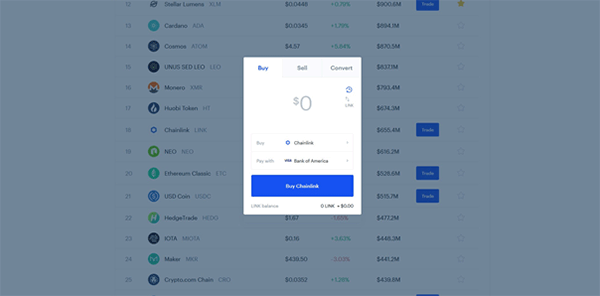
There, you’ll be prompted to buy, sell, or convert your cryptocurrency. Follow the prompts and be sure to review your order before finalizing.
Coinbase charges a spread fee of about 0.5% for buying or selling cryptocurrencies. In addition, there is what’s called a Coinbase Fee based on whichever is greater – a flat fee or a variable percentage fee determined by region, product feature, and payment type.
Buying/Selling Your Remaining Altcoins on Binance and Other Exchanges
Some altcoins are not available on Coinbase, so you’ll need to use another exchange in order to buy them. Most U.S. investors can open an account with Binance.US.
Note: Binance.US launched in September 2019. While the firm is working to bring more buying options to customers, you won’t be able to start an account – at least initially – if you’re located in one of the following U.S. states: Alaska, Connecticut, Hawaii, Idaho, Louisiana, New York, North Carolina, Texas, Vermont, and Washington.
If that’s the case for you, there are a couple of other alternatives you can check out. I recommend you research and look into Bittrex (click here to view its support page, which will help you set up an account), Crypto.com (click here to view its User Guide), and Kraken (click here to learn how to create an account). The regulatory environment is frequently changing, and buying and selling cryptos should get much easier over time.
If you have any questions regarding how to set up your account, feel free to email our customer service team at [email protected]. To help you out, here are instructions for setting up a Binance account.
Go here to start your Binance account. The landing page should look like this:
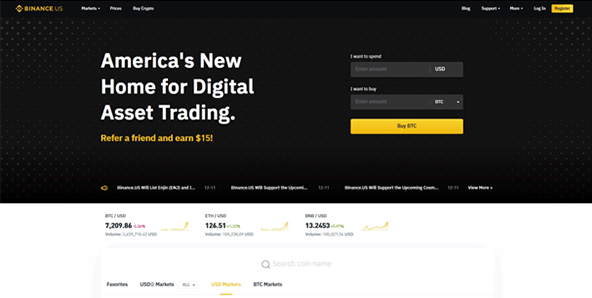
Click on “Register” in the upper right-hand corner and create your free account.
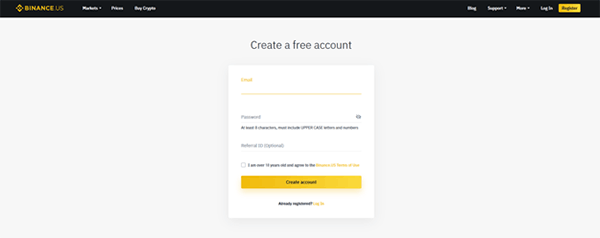
Fill in your email address and password. Make sure your password includes uppercase letters and numbers. Next, click on the “Create account” button.
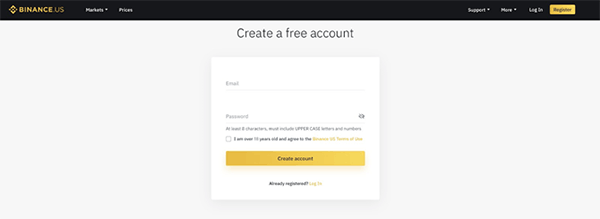
You will receive a verification email in your registered email inbox. Go to your email and confirm your registration.
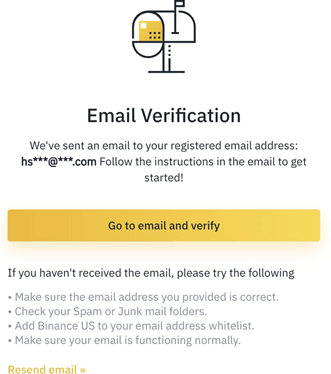
Click on the “Verify Email” button to confirm your registration.
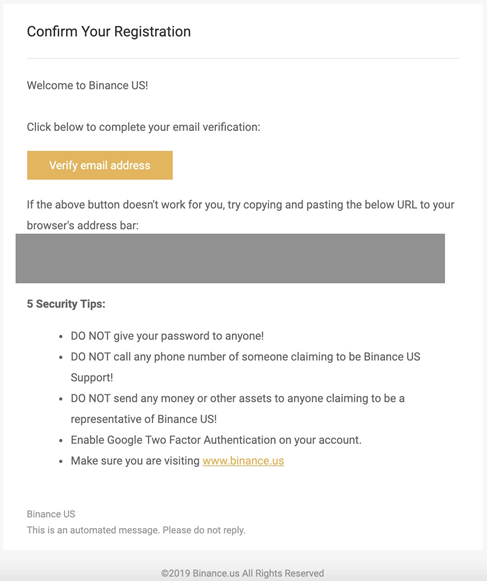
Congratulations! Your Binance.US account has been activated!
Now you’ll have to fund your account. You can make deposits using a debit card, by linking a bank account, or through a wire transfer. The site has simple, step-by-step instructions you can follow.
To link a bank account, go to “Settings” and click “Manage.”
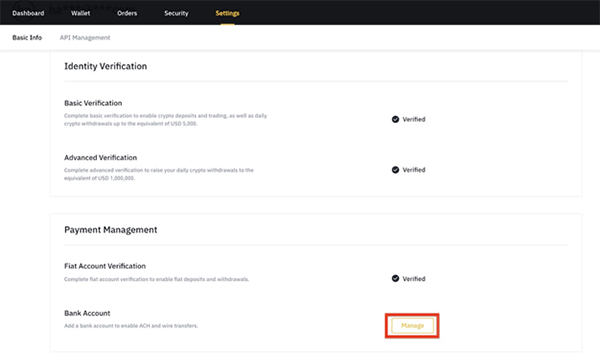
Click “Link a New Account.”

Select the payment method you prefer, fill in the required information, and click “Next.” You can check the linked account by going to the “Settings” page.
Note that Binance has trading fees described as “maker” and “taker” fees. Trades placed by filling partially or fully, before going on the order book, are “taker” trades. Market orders are always taker trades. “Maker” fees include limit orders as they add volume to the order book. For beginners, both maker and taker fees are 0.1%.
Binance’s FAQ section has many helpful tips. Go here to check it out.
How to Store Your Cryptocurrency Safely
Now that you’ve purchased your cryptocurrency, you’ll need to store it. This is done by using what’s known as a cryptocurrency wallet. Cryptocurrency wallets are essentially secure software programs that can store, send, and receive a digital currency, like bitcoin.
Coinbase offers a USD Wallet and Hosted Digital Currency Wallet Service for free. You will pay network transaction fees that are disclosed at the time of purchase.
You can find your wallet address from the “Advanced” menu by clicking on the drop-down arrow next to your name, located near the top right corner of any page.
You can then send digital currencies to an external wallet by clicking “Send/Receive” on the left sidebar of any page.
Binance offers its own storage. FDIC insurance coverage is also available for U.S. dollar deposits.
Summing Up
Cryptocurrencies have taken the world by storm as one of the most promising technologies designed for the online, digital age. They’ve made savvy investors rich beyond their wildest dreams, and the fun is just getting started. This whole new asset class can serve as a store of value, a digital gold, and as a widely available means of value exchange, like the U.S. dollar or the euro. Crypto tokens can also be used as digital versions of real-world assets like real estate that can be traded more efficiently and opened up to more investors.
Blockchain technology is the foundation that makes trading and storing cryptocurrencies possible. It provides the essential features of security and nearly impossible-to-manipulate record keeping that are needed to make digital currencies a safe and trusted alternative to fiat currencies like the U.S. dollar. Crucially, blockchain helps disentangle cryptocurrencies from a centralized operator, like an unaccountable central bank run by out-of-touch monetary authorities, and puts the power back into the hands of a widely distributed group of owners.
The industry has come a long way in making the buying and selling of cryptocurrencies approachable to everyday folks. It might take slightly more work than simply trading stocks through an online broker. But putting in the extra effort to gain outsized benefits is what separates the rich from the rest.
It could easily make you the next crypto millionaire.
The post Altcoin Investing for Beginners appeared first on InvestorPlace.
dollar
gold
monetary
markets
money supply
central bank
store of value

Argentina Is One of the Most Regulated Countries in the World
In the coming days and weeks, we can expect further, far‐reaching reform proposals that will go through the Argentine congress.
Crypto, Crude, & Crap Stocks Rally As Yield Curve Steepens, Rate-Cut Hopes Soar
Crypto, Crude, & Crap Stocks Rally As Yield Curve Steepens, Rate-Cut Hopes Soar
A weird week of macro data – strong jobless claims but…
Fed Pivot: A Blend of Confidence and Folly
Fed Pivot: Charting a New Course in Economic Strategy Dec 22, 2023 Introduction In the dynamic world of economics, the Federal Reserve, the central bank…















